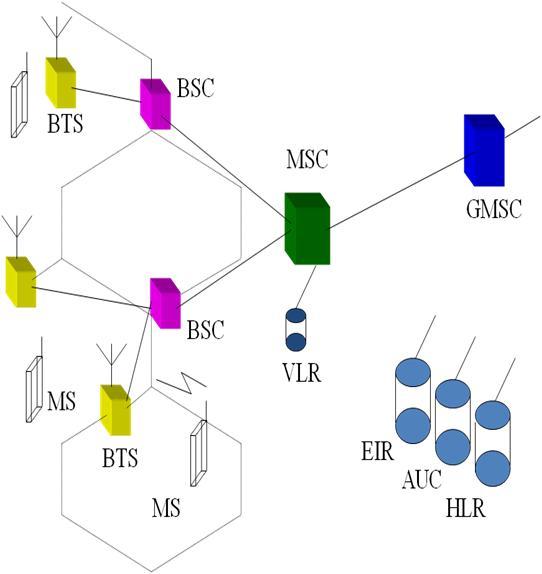Introduction to Seminar Topic on GSM Architecture:
Mobile Station (MS): The MS includes all user equipment and software needed for communication with a wireless telephone network. It refers to the mobile phone. MS includes four main components namely Mobile Terminal (MT) which offers the common function that is used by all the services the MS offers, Terminal Interface (TE) which is a peripheral device of the MS and offers services to the users, Terminal Adapter (TA) that hides radio specific characteristics, and Subscriber Identity Module (SIM).
Cells: The cells are individual sets of transmitting and receiving equipment which along with its neighbor cells gives a complete coverage area of the network service area. The cell is an area of radio coverage which the network identifies with the Cell Global Identity (CGI).
Base Tran receiver System (BTS): It encodes, encrypts multiplexes, modulates and feeds the RF signal to the antenna. It consists of the trans receivers and antennas. It communicates with MS and BSC.
Base Station Controller (BSC): It has high capacity switch that provides functions like MS handover, power control, and call setup, transcending and rate adaptation functionally, radio channel assignment and the collection configuration data.
Mobile Service Switching Centre (MSC): It is the main part of the network. It manages communication between GSM and other networks. Its functions are call setup, basic switching and call routing, billing information and collection, mobility management, location updating, inter BSS and inter MSC call handoff.
Home Location Register (HLR): It is the database which contains data about mobile subscribers. Whenever a subscriber buys any subscription from any operator, his complete profile is recorded in HLR. When the subscriber moves to another location his MSC/VLR ID is accordingly updated.
Visitor Location Registers (VLR): It is a temporary database which updates whenever new MS enters its area. It controls mobile roaming in its area. It reduces number of queries to HLR. The database contains IMSIm TMSI, MSISDN, MSRN, Location area, Authentication key.
Authentication Centre (AUC): It is a protected database that stores a copy of secret key stored in subscribers’ SIM card and protects against intruders in air interface. It provides HLR with authentication parameters, cipher keys and algorithms and provides security triplets.
Network Management Centre (NMC): It provides hierarchical network management of the complete GSM system. It is responsible for operation and maintenance at the network level support by the OMCs which are responsible for network management.
Equipment Identity Register (EIR): It is the database that contains a list of all valid mobile equipments on the network. It is made up of white list, black list, gray list.
Gateway MSC (GMSC): This is used to connect different network operators to connect with their own network. The call first reaches the GMSC, the location of the called subscriber is searched in HLR, this information is send to the GMSC, then the GMSC routes the call to the correct MSC. The MSC is now connected with the MS, and the subscribers are connected.
Operation and maintenance centre (OMC): OMC is connected to all the devices in the SS and to the BSC and BTS. The links between a GSM/PLMN network and the other PSTN, ISDN or PLMN networks is on International or National Transit Exchange level. All the incoming calls to a GSM/PLMN Network are send to GMSC, then to MSC/BSC coverage area and finally to the correct BTS. MSC can have only one service area.
Location Area (LA): The MSC/VLR service area is divided into several location areas. A location area is a part of MSC/VLR in which a mobile moves freely. In this area, a paging message is broadcasted in order to find the called subscriber. A location area can have several cells and depends on one or more BSCs but it belongs to same MSC/VLR. The system identifies the location using the Location Area Identity (LAI).
Cellular Structure: The covering area of an operator is divided into cells. It is the area covered by one or small collection of transmitters. The size of a cell is determined by the power of the transmitter. In cellular system transmitters of low power are used to enable re usability of frequencies. The frequency band allocated to a cellular mobile radio system is distributed over a group of cells and this distribution of frequency will be repeated in all the covering area of the operator. The distance between the cells using the same frequency should be sufficient to avoid interference. The cells are grouped into clusters. The number of cells in the clusters should be small to increase the number of channels per cell. But a balance has to be maintained in order to avoid interference.
Download Seminar Topic on GSM Architecture .

